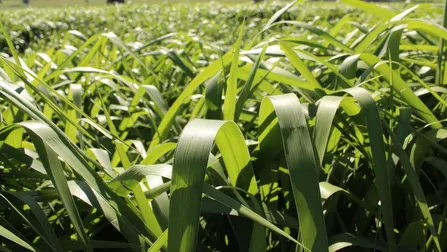
Indicação
Indicada para solos de alta fertilidade. Pela boa tolerância ao alumínio do solo, possui bom desenvolvimento do seu sistema radicular conferindo a cultivar uma ótima rebrota e boa adaptação na seca. Recomenda-se para bovinos em fase de cria, recria e engorda, leite, e também para equinos, caprinos e ovinos.
Megathyrsus maximus cv. Atlas
Panicum maximum cv. Atlas
Alta Fertilidade
Pastejo direto e silagem
20 a 22 t/ha/ano de matéria seca (M.S.)
10 a 12%
De 1,50m a 2,00m
65 a 70%
Muito boa
Boa
Boa
Perene
Características Agronômicas
É uma espécie forrageira exigente em fertilidade do solo, cuja principal característica é a sua tolerância à acidez de alumínio, presente no solo.
Utilização e Manejo
O Atlas é uma variedade indicada para solos de boa fertilidade, corrigidos e adubados. Apresenta em destaque, a boa tolerância a solos com teor elevado de alumínio, componente do solo que confere acidez e inibe o desenvolvimento radicular das forrageiras. Apesar do alumínio, consegue um sistema radicular profundo e abundante, característica essa que confere a planta uma ótima rebrota e boa adaptação na seca. Possui boa qualidade nutricional, podendo ser utilizada para todas as categorias bovinas de corte e leite, equinos, caprinos e ovinos. Em sistema rotacionado de pastejo é recomendado intervalo de descanso de 25-28 dias. Deve-se evitar que a planta ultrapasse a altura de 1,50m, pois em pasto vedado por muito tempo, principalmente no período chuvoso, a forragem se torna madura, lignificada, perdendo a qualidade nutricional e a aceitação pelos animais. A touceira do Atlas aumenta de diâmetro após os cortes ou pastejo, pois aumenta o número de perfilhos e isso é mais facilmente observado nesta cultivar.
Origem
A cultivar híbrida de forrageira Atlas é oriunda de cruzamento artificial, realizado em 1993, em casa-de-vegetação pela Matsuda, cruzando fêmea sexual de Tobiatã com K-68, acesso originário da Costa do Marfim/África, que nunca chegou a ser um cultivar comercial. Em 1994 foi realizada a seleção de genótipos superiores, em progênies segregante para apomoxia e sexualidade e no ano seguinte o teste de progênies para separação de progênies para separação de híbridos F1 apomíticos dos híbridos F1 sexuais. Nos anos de 1998 e 1999 foi avaliada a resistência deste híbrido quanto à resistência ao alumínio (presente em solos ácidos) tanto em condições de laboratório (em soluções nutritivas) como de campo (em solos comprovadamente ácidos com presença de alumínio). Os dois anos seguintes, o cultivar foi avaliado em testes com animais verificando a capacidade de suporte, resistência ao pisoteio, potencial de rebrota, persistência, tolerância à seca, potencial de produção de sementes, etc.
Características Morfológicas
É uma planta cespitosa de ciclo perene, com altura entre 1,5 a 2,0 m, alto perfilhamento basal, colmo de diâmetro médio, comprimento do internódio curto, colmo com pouca cerosidade, folha apresentando pouca pilosidade na bainha, comprimento da lâmina também médio e de coloração verdeclara. O ciclo de florescimento é médio, com período definido para florescer (florescimento determinado).





